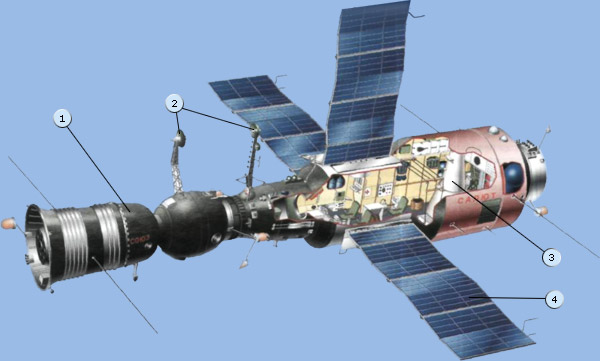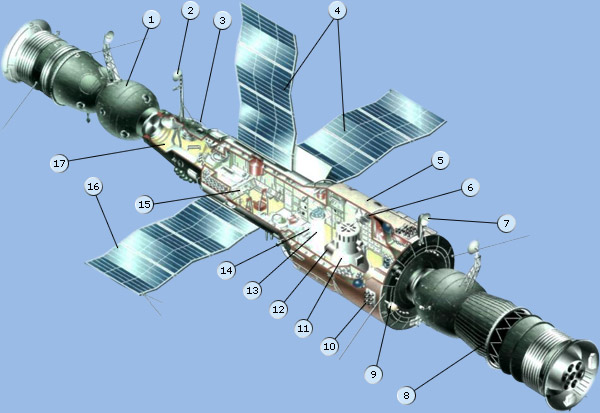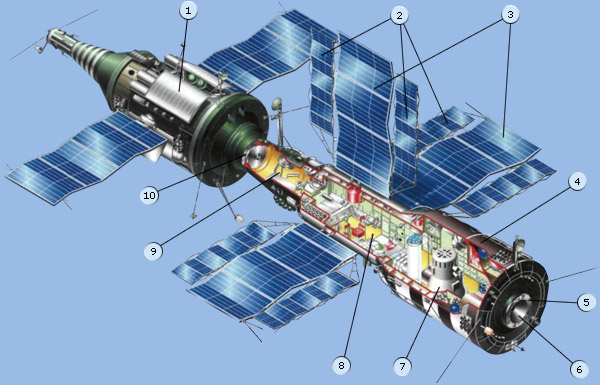Long-term orbital station (DOS)
First phase – first generation space stations.
The development of a long-term orbital station (DOS), designated as 17K, began at ÖÊÁÝÌ (now NPO Energia) under the direction of Mishin V.P., Chief designer, at the end of 1969.
In addition, the simultaneous manufacturing of two stations had started - DOS-1 and DOS-2, and later two more slightly different stations - DOS 3 and DOS 4 – were made. All four space stations were created on the basis of the manned orbital space station Almaz frame structures, delivered from ÖÊÁÝÌ (now NPO Machine-building Industry).
The DOS-1-4 space stations weighing about 20 tons had one docking port. The duration of the space station flight was limited by life support system resources and fuel supply. These stations were classified as 1st generation space stations.
The DOS-1 and DOS-2 were designed for implementing the space flights of 2-3 crews, consisting of three cosmonauts each, with the duration of up to one month as well as for carrying out scientific and technical experiments, medical, and astrophysical research.

On April 19, 1971 the DOS-1, named Salute, was launched. The Soyuz-11 crew was the only one that operated onboard the station (the crew died during descent). On the 29th of July, 1972 the DOS-2 was launched, however, due to the Proton rocket booster failure, the space station did not enter an orbit.
The DOS-3 and DOS-4 were designed for implementing the space flights of 2-3 crews, consisting of two cosmonauts each, with the duration of up to two months in order to carry out scientific and technical experiments, astrophysical and medical experiments and research.
On May 11, 1973 the DOS-3 was launched. Immediately after the insertion of a space vehicle the entire fuel supply of attitude thrusters has been consumed by the motion control system in order to compensate self-induced vibrations of the station. The station attitude was not maintained, thus it could not operate in a manned mode and was called Cosmos-557. On the 26th of December, 1974 the DOS-4, named Salyut-4 was launched. Two crews were operating onboard the station.
Second phase - 2nd generation space station. The DOS-5 and DOS-5-2 space stations were built on the basis of the previous DOS space stations in the 1970s, at NPO Energia under the leadership of Glushko V.P., Ñhief designer. The design of the DOS space station was refined, and the onboard scientific equipment was updated. The space stations were equipped with two docking ports and belonged to the second generation space stations. Apart from the manned transport Soyuz spacecrafts, the station maintenance system was supplemented with specifically designed automatic transport cargo vehicles (ÒÊÃ) Progress, which allowed to replenish the station supplies regularly with different consumable materials (fuel, life support system components, food, water and other materials), to replace parts of scientific equipment when necessary and perform corrections of the space station motion trajectory.
Besides, it became possible to dock the second transport vehicle, which delivered visiting crews to the station or to dock a crew rescue vehicle for evacuating a prime crew if necessary. As a result, the operating life of the stations and the duration of crews’ space flights onboard have sharply increased.

Each of these space stations was designed for long-term space flights of up to five prime crews, consisting of two cosmonauts each, and for short-term space flights of visiting crews, consisting of two cosmonauts each as well. The DOS-5-2 station prime and visiting crews could consist of three cosmonauts. Various scientific, biomedical, technological experiments and research as well as space flights of foreign astronauts on the Interkosmos program were performed onboard the space stations.

The DOS-5 space station, named Salyut-6, was launched on September 29, 1977. During the operation of the space station, 16 manned transport Soyuz and Soyuz-T spacecrafts that delivered 5 prime and 11 visiting crews were docked. Twenty seven cosmonauts operated onboard the station: there were 19 Soviet and 8 foreign crews. Six Soviet cosmonauts have flown to the station twice. Twelve ÒÊÃ Progress vehicles were docked to the station.
The DOS-5-2 space station, named Salyut-7, was launched on April 19, 1982. Ten Soyuz-T transport manned vehicles that delivered 5 prime and 5 visiting crews were docked to the station. Totally, there were 21 cosmonauts operating onboard the station: 19 Soviet cosmonauts and 2 foreign ones. Three Soviet cosmonauts have visited the station twice, and V.A. Djanibekov has been there three times. Thirteen ÒÊÃ Progress cargo vehicles were docked to the station. Besides, two unmanned ÒÊÑ Cosmos-1443 and Cosmos-1686 vehicles were docked to the station. The space station together with the docked ÒÊÑ Kosmos-1686 were moved to a high circular orbit with an altitude of 480 km on August 22, 1986, after the completion of the station manned space flight program. Later, the station was supposed to be returned to the Earth inside the Buran vehicle cargo bay. Due to the high solar activity and increased density of the atmosphere, the station was deorbited together with the TÊÑ ahead of the expected date (February 7, 1991).
All six DOS space stations were launched by a three-stage LV Proton (UR500Ê).


